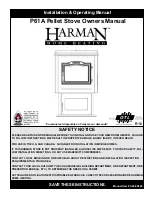
13
Installation
8. The pipe must extend at least 12” (30 cm) away from the building. If necessary, bring another
length of pipe to the outside of the home to connect to the first section. Do not forget to place
high temperature silicone around the pipe that passes through the thimble if required by vent
manufacturer.
9. Install a vertical pipe, or if all requirements for direct venting are met, install vent termination. The
stainless steel cap termination manufactured by the vent manufacturer is recommended. However,
when the vent terminates several feet above ground level and there are no trees, plants, etc. within
several feet, a 45° elbow can be used as termination. The elbow must be turned down to prevent
rain from entering.
NOTE:
• It is recommended that horizontal through wall installations have 3 to 5 feet (91 to 152 cm) of vertical
pipe in the system to help naturally draft the unit in the event of extreme weather or a power outage.
• Some horizontal through wall installations may require a “T” and 3 to 5 feet (91 to 152 cm) of vertical
pipe outside the building to help draft the unit. This may be required if a proper burn cannot be
maintained, after the stove has been tested and the airflow set. This is due to the back pressure in the
exhaust caused by airflow around the structure.
• Follow vent manufacturer guidelines for installation, clearance to combustibles, and sealing of venting.
High temp Sealant must be used when connecting vent pipe to the unit’s starter pipe. Improper seals
at the vent joints may cause combustion by-products to leak into the room where installed - seal as
required by vent manufacturer.
Wall framing
Wall thimble
Termination cap
Vent pipe
Horizontal frame
for thimble
Figure 13: Straight through Wall Installation - Side View.














































